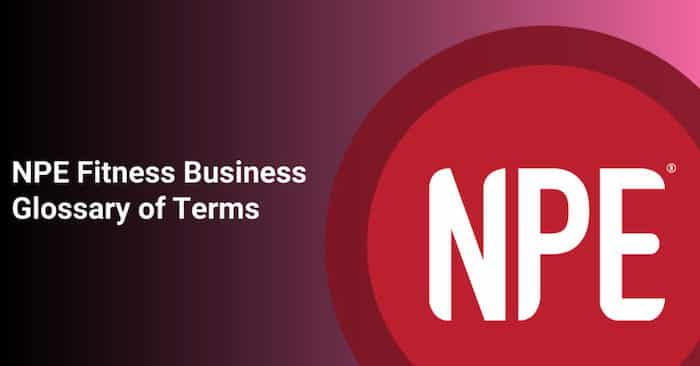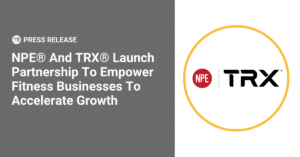91 Fitness Business Terms You Should Know To Increase Your Competence and Confidence
By Sean Greeley

How strong is your business vocabulary?
Most fitness professionals and business owners start out with a vague awareness that there’s a lot more to building a business than they initially thought.
But without names for what needs to be done (and an understanding of the environment they’re now operating in), they end up feeling lost, confused, and overwhelmed.
Names give you power. They increase your comprehension and allow you to accelerate breakthroughs in cloudy thinking so you can focus on specific, necessary actions required to achieve your goals.
Here we offer you 91 key business terms that will prove crucial on your fitness business journey. Don’t worry about learning them all at once. We recommend you bookmark this page and come back often (as we’ll continue to update it too).
NOTE: We’ve organized these terms into functional areas of fitness business (and personal) growth aligned to the NPE Methodology and the Five Core Disciplines of success. If you’re not familiar with our methodology, then you can read more about it (and how we approach things differently) here.
CORE DISCIPLINE #1:
LEAD YOURSELF & OTHERS
Celebrate Activity: The feeling of accomplishment in remaining busy, even though the work does not align with your goals and commitments.
Content with insight: The feeling of accomplishment a person gets from discovering the right answer to a problem, and so takes no further action to fix the problem.
Core value alignment: The state where two or more people share beliefs in what is desirable and how those desires should be achieved. Crucial for team-building and serving ideal clients.
Empowered stance: The mindset of applying new knowledge with action, making commitments, being authentic, making growth choices, and functioning with integrity.
Fears: Belief there is a threat that will cause pain. When fears are irrational and interfere with growth choices, they need to be attacked to be overcome, not approached tentatively.
Goals: Specific objectives an action or campaign of actions is designed to achieve.
Limited beliefs: An unspoken or even unaware thought that prevents a person from moving forward, i.e., “I always get hurt when I try to get in shape,” “I just want to tone up,” or even “Something’s going to go wrong–Things just don’t work out for me.”
Mindset: The inner stance someone takes, whether strong or weak, that ultimately determines success or failure.
Mission: A campaign, action, or series of actions designed to achieve a specific part (or all) of a vision.
Purpose: The reason or reasons one wants to achieve a vision, such as running a fitness business and inspiring clients to meet their health and fitness goals.
SMART goals: Objectives that are Specific, Measurable, Attainable, Relevant, and Time Date for Achievement.
Values: Basic beliefs that guide people’s actions and attitudes.
Vision: What the organization (or a person) wants to achieve, an aspiration of what you want to achieve; literally, a vision of what you want your world to look like.
CORE DISCIPLINE #2:
GET MORE CLIENTS
Avatar: A fictional biography of the client you wish to serve, who has all the demographic, psychographic and geographic characteristics–and fitness goals of your ideal client.
Capture: How you collect contact information from people you’ve attracted to your messaging so you can continue the conversation, e.g., landing pages, phone scripts, in-person scripts and sign-up sheets.
Client Base: The number of clients you have.
Close: The decision the client makes to commit to enroll in your programs. It’s not something you do to someone; it’s offering an opportunity to your prospective client to solve their problem and make them comfortable with saying yes.
Demographics: Statistical characteristics of particular groups of people, e.g,. age, income, sex, etc.
Differentiate: A marketing term for how your products and services are distinguished from those of competitors.
Discovery: The process of learning why a prospective client is coming to you for help.
Fitness Marketing Lifecycle: The entire process of finding and serving clients. Attract, Capture, Nurture, Convert, Serve, Referral, Upsell, and Renewals.
Geographic: Statistics about the number of prospective clients within reach of your business.
Market: The pool of potential clients where you are seeking to find new clients, such as age, geography, and health and fitness needs.
Marketing: The process of creating business relationships and satisfying customers/clients.
Modality: How you help the client achieve health and fitness goals, e.g., nutrition counseling, weight-lifting, yoga, Pilates™, martial arts, kettlebells, conditioning, etc.
Model/business model: A business model answers the fundamental question of how a business is structured to deliver value to the market in a sustainable way (i.e., earn a profit).
Needs identification: The part of the sales system where you clearly state the challenge or struggle the client is having (which they cannot solve on their own).
Networking: Networking is a marketing strategy that you can use to build new relationships and strengthen existing ones. The goals are: identify and develop referral partners, build your list of contacts, gain new clients (directly), and become THE go-to person. Not to be confused with “net-sitting” or “net-waiting.” NetWORKING.
Nurture: 81% of sales happen after 7 or more contacts. But 85% of the time, fitness business owners stop after just one or two contacts. Nurturing is continue to provide value to prospective clients so they get to know, like, and trust you.
Objection: When you go through your sales consultation and someone says “no” and gives you a reason. Use a 5-step process to handle the objection (listen, question, answer, confirm, and ask for the sale again).
Offer: Presenting an opportunity for service to a client, for them to accept or reject.
Package: The length of time the client commits to your service; usually 3-, 6-, and 12-month programs.
Partners: Non-competitive vendors who serve the same clients and can refer you clients (and vice versa). One of the most effective methods of lead generation for your ideal clients.
Presentation: Your 7-step prepared sales consultation, where you inspire people to commit to their health and fitness goals.
Pre-qualification: The first step in a sales process where you determine if this person is someone is qualified for a sales consult. You determine upfront (1) if you can help, (2) they can afford your services, and (3) they are ready and willing (with all decision-makers present) to make a decision at the end of the consult.
Price/Pricing: The process of setting compensation for your services at a profitable rate for you and commensurate with the value you provide.
Problem-building: The process of fleshing out all the impacts (physical, emotional, social) health and fitness problems have on a prospective client’s life.
Psychographics: Statistics about the attitudes, aspirations, and other psychological criteria.
Public speaking: One of your most effective methods of lead generation and getting your message out.
Rapport: The process of establishing the level of comfort and trust necessary to identify someone’s real health and fitness goals.
Referrals: When clients recommend other people to you; should be regularly asked during renewals, positive feedback, and incentivized.
Renewals: When a client signs up for your service after the expiration of the first term of service. High renewal rates are signs of high levels of client satisfaction.
Sales System: A sequence of steps to take that guides people toward fully committing to their health and fitness goals and enrolling in your programs.
Signage: Messaging and design to communicate with your intended audience.
Testimonials: Your documented record of results from clients who are happy to share their positive client experience in your marketing materials.
Upsell: The process of offering clients additional services and upgrades for a more premium price.
CORE DISCIPLINE #3:
SERVE PASSIONATELY
Churn: The number of clients coming into and leaving the business over a specific period of time.
Client experience: A description of the entire relationship between client and your organization, from initial contact through client service through off-boarding.
Relationship: How you ensure clients feel cared for and valued.
Value Equation V = CE + R + R. Value = Client Experience + Relationship + Results: How to measure total value you provide to clients. Consists of the quality of the client experience, the relationship, and the results the client experiences.
CORE DISCIPLINE #4:
INCREASE PROFITS
Asset: Everything you own that has value, including claims against others (such as accounts receivable), and tangible items such as cash, equipment, buildings, land, and inventory.
Break-even point: When you reach a sales level where revenue equals your total costs.
Break-even sales revenue: The amount of money a business needs (weekly or monthly) to pay for its direct product costs and fixed costs; it will not include profit.
Cash-flow statement: A financial statement that shows when cash comes into your business and when it goes out; it’s a statement of what you collect and what you pay out.
Cost of revenue: You calculate this by adding all of your expenses that result from your direct labor on costs on services sold.
Current assets: This is everything you currently own that has value: Your cash, accounts receivable, inventory, all term deposits and prepaid expenses that will convert to cash within one year.
Current liabilities: This is everything you owe: your operating loans, bills (accounts payable) and accrued charges, plus outstanding checks, wages for your employees and contractors, long-term debt payments, and your taxes due within a year.
Current ratio: This points out how easily your business can pay its debts. To calculate, divide your Current Assets by your Current Liabilities. The higher the ratio, the more easily you can pay your debts.
Debt/equity ratio: Your business’s debts compared to what your business is worth (equity). To calculate, divide Total Liabilities by Equity.
Depreciation: Your equipment and other fixed assets have a useful life-span and is worth less as time goes on. Depreciation is an accounting term referring to a charge taken on your income statement that writes off the lowering value of this equipment over time.
Equity contribution (capital stock): The amount of cash owners and investors have invested in exchange for a share of ownership of the business.
Fixed assets: This means land, buildings, and equipment likely to have a useful life to the company.
Gross profit (or gross margin): The profit earned before deducting operating and administrative expenses; calculate by subtracting Cost of Revenue from Sales.
Income statement: This is a financial statement that shows exactly how much money a company has made (or lost) during a specific period of time (net profit or net loss). You document all revenue received from sales, then subtract the total cost of operating the company.
Incorporation: This is a process of making a business a separate legal entity from its owner. (It limits liability.)
Intangible asset (soft asset): These are non-physical assets, such as patents, goodwill, and trademarks.
Interest coverage ratio: This is a debt and profitability ratio to show how easily your company can pay interest on outstanding debt. It’s ratio of net income (before extraordinary items and income tax) of the business.
KPIs: Key performance indicators. KPIs are the metrics that measure the health of the business and its long-term viability.
Leverage: Your debt compared to equity. The more debt used to finance a company, the more “leveraged” it is and the more at risk it is.
Liquidation value: How much money you can sell an asset for.
Liquidity: This describes how easily you can convert assets into cash.
Long-term liabilities: Any liability you are not scheduled to pay off in one year, such as debts or loans.
Net worth: How much equity you own in a business; calculate by deducting Total Liabilities from Total Assets.
Operating (revolving) loan: Short-term financing to support cash-flow support or cover day-to-day operating expenses.
Overdraft: When someone tries to withdraw more money from an account than is available.
Partnership: A form of structuring a business made up of two or more people. The partners share an agreement about the percentage of responsibility, profits, and/or losses.
Payment terms: The negotiated conditions for payment.
Personal guarantee: When a business owner guarantees to a lender that the owner will take personal responsibility for repaying a business loan or debt.
Profit margin: The ratio of profits (generally pre-tax) to sales; calculate it by dividing Pre-tax Profit by Sales/revenues.
Receivables: Invoices that have been billed to clients but not paid; usually known as Accounts Receivable.
Recurring revenue: Revenue charged each month to a client (usually credit card) for the length of a contract; a key metric because recurring revenue allows fitness business owners to focus on building the business and not scrambling to cover expenses and payroll.
Return on investment (ROI): A test of profitability where you divide Net Profits by Total Assets.
Sales growth: Subtract the current year’s sales and the previous year’s sales and divide by the previous year’s sales.
Sole proprietorship: A form of structuring a business in which one person is the only owner. There is no distinction between the owner’s and the businesses’ responsibility regarding the commitments made on behalf of the business.
Term Loan: A loan obtained for a specific length of time, and usually not longer than the useful life of the asset you purchase with the loan.
Variable costs: These are your costs that change depending on the level of sales or production, such as discounts and sales commissions.
Working capital: The money you have to work with after you deduct all your liabilities. Net working capital is your current assets minus current liabilities.
CORE DISCIPLINE #5:
LIVE BETTER
Business Operator: A fitness professional who is basically a one-person show, even though they may hire some assistants. They wear every hat in the business and make all the important decisions (or all the decisions). The business stops when the operator stops.
Business Owner: Someone who has made a transition from business operator to entrepreneur, a person who is building a business that can run itself.
Work IN the business: Serving clients and performing day-to-day tasks directly.
Work ON the business: Building the business and directing others to serve clients and perform day-to-day tasks.
Summary
Understanding (and winning) the game of business requires you to understand the language of business.
Investing time to increase your business vocabulary will increase your comprehension of the environment you’re operating in, and allow you to breakthrough cloudy thinking to focus on specific, necessary actions required to achieve your goals.
Remember to “winning is the will to prepare.”
And winners take active responsibility for their success.
Everybody wants to win, but ONLY winners discipline themselves to do the work required.
Bookmark this page and come back often.
Not familiar with NPE Methodology and the Five Core Disciplines of success?
We do things differently. Most courses only teach specific skills, such as running Facebook ads or selling six-week challenges. We believe this creates fragmented learning that leads fitness business owners into dead ends. For long-term business success (and profitability), you need to learn and master five core disciplines.







